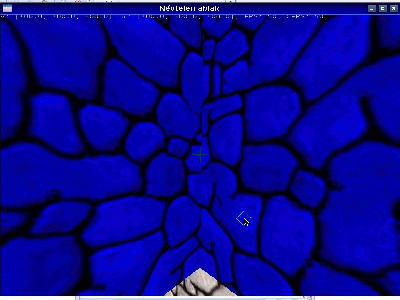Je viens d'activer l'abattage de la face arrière et je remarque un comportement étrange: lorsque tous les sommets de mon triangle sont en dehors de la vue et que 2 d'entre eux sont derrière moi (je pense), le triangle disparaît.
Alors pour le voir, voici un GIF.

Je soupçonne que la matrice de projection inverse l'ordre des deux sommets lorsqu'ils tombent derrière moi et modifie l'enroulement de mon triangle.
Mais on ne sait pas pourquoi les triangles disparaissent uniquement si tous les sommets sont hors de vue ...
Comment contourner ce problème, si possible?
Je développe sur Linux si cela compte.
MISE À JOUR:
Il a été souligné que cela n'était peut-être pas dû à l'abattage de la face arrière. Je l'ai désactivé et je peux en effet le reproduire. Les cubes sont de 20 × 20 et la vue de champ verticale est de 90 °. Sa taille apparente verticale remplit grossièrement la fenêtre.
MISE À JOUR 2:
Ok je posterai la partie pertinente du code, les matrices de projection et de vue sont configurées en utilisant mes propres fonctions:
void createViewMatrix(
GLfloat matrix[16],
const Vector3 *forward,
const Vector3 *up,
const Vector3 *pos
)
{
/* Setting up perpendicular axes */
Vector3 rright;
Vector3 rup = *up;
Vector3 rforward = *forward;
vbonorm(&rright, &rup, &rforward); /* Orthonormalization (right is computed from scratch) */
/* Filling the matrix */
matrix[0] = rright.x;
matrix[1] = rup.x;
matrix[2] = -rforward.x;
matrix[3] = 0;
matrix[4] = rright.y;
matrix[5] = rup.y;
matrix[6] = -rforward.y;
matrix[7] = 0;
matrix[8] = rright.z;
matrix[9] = rup.z;
matrix[10] = -rforward.z;
matrix[11] = 0;
matrix[12] = -vdp(pos, &rright);
matrix[13] = -vdp(pos, &rup);
matrix[14] = vdp(pos, &rforward);
matrix[15] = 1;
}
void createProjectionMatrix(
GLfloat matrix[16],
GLfloat vfov,
GLfloat aspect,
GLfloat near,
GLfloat far
)
{
GLfloat vfovtan = 1 / tan(RAD(vfov * 0.5));
memset(matrix, 0, sizeof(*matrix) * 16);
matrix[0] = vfovtan / aspect;
matrix[5] = vfovtan;
matrix[10] = (near+far)/(near-far);
matrix[11] = -1;
matrix[14] = (2*near*far)/(near-far);
}Matrice de projection configurée avec cet appel:
createProjectionMatrix(projMatrix, VERTICAL_FOV, ASPECT_RATIO, Z_NEAR, 10000);(VERTICAL_FOV = 90, ASPECT_RATIO = 4.0 / 3, Z_NEAR = 1)
Le dessin de niveau est simplement:
void drawStuff()
{
GLfloat projectView[16];
glClearColor(0, 0, 0, 1);
glClear(GL_COLOR_BUFFER_BIT | GL_DEPTH_BUFFER_BIT);
createViewMatrix(viewMatrix, &camera.forward, &camera.up, &camera.pos);
multiplyMatrix(projectView, viewMatrix, projMatrix); /*< Row mayor multiplication. */
glUniformMatrix4fv(renderingMatrixId, 1, GL_FALSE, projectView);
bailOnGlError(__FILE__, __LINE__);
renderLevel(&testLevel);
}Les cubes sont rendus mur par mur (l'optimisation sera une autre histoire):
for (j = 0; j < 6; j++)
{
glBindTexture(GL_TEXTURE_2D, cube->wallTextureIds[j]);
bailOnGlError(__FILE__, __LINE__);
glDrawElements(GL_TRIANGLE_FAN, 4, GL_UNSIGNED_INT, (void*)(sizeof(GLuint) * 4 * j));
bailOnGlError(__FILE__, __LINE__);
glUniform4f(extraColorId, 1, 1, 1, 1);
bailOnGlError(__FILE__, __LINE__);
}Vertex shader:
#version 110
attribute vec3 position;
attribute vec3 color;
attribute vec2 texCoord;
varying vec4 f_color;
varying vec2 f_texCoord;
uniform mat4 renderingMatrix;
void main()
{
gl_Position = renderingMatrix * vec4(position, 1);
f_color = vec4(color, 1);
f_texCoord = texCoord;
}Shader de fragment:
#version 110
varying vec4 f_color;
varying vec2 f_texCoord;
uniform sampler2D tex;
uniform vec4 extraColor;
void main()
{
gl_FragColor = texture2D(tex, f_texCoord) * vec4(f_color) * extraColor;
}Le tampon de profondeur est simplement configuré en l'activant.